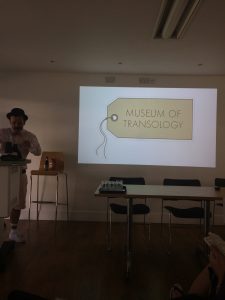
Bridget Millmore (PhD, 2015) recalls how the University of Brighton’s Postgraduate Design History Society helped her find her feet as a researcher
Ten years ago I was a student on the MA in Design History and Material Culture. Having worked for many years, the process of returning to study as a mature student was a bit like travelling to a new place without recognising the language or terrain. Things had changed since my undergraduate days. As a result I was unfamiliar with what was expected; unsure whether postgrad study was for me and uncertain about how to use the scholastic resources that were offered. Should I be reading all the books on a reading list? Could I fathom the details of the required referencing system? How did I hunt down a particular journal article or discover which online sources might be most useful for my research? Of course, these feelings of uncertainty waned as the course progressed and my confidence in researching and writing grew. However, the questions related to my course and research continued; questions that did not always lead to answers but to ambiguity and complexity. As well as encouragement from fellow students and the course tutors, one of the most significant support networks for me was the University of Brighton’s Postgraduate Design History Society (PDHS).
The Society was a lifeline when I had questions and quandaries, needed suggestions for my research or just reassurance that others were facing similar challenges. It is a student run group of postgraduates, all at different stages of their studies, from novice MA students to experienced PhD scholars and early career academics. The Society (that was set up in 2005) offers a friendly and encouraging network – a place to go to with your questions, for example, what to include in a word count, how to deal with an apparent ‘dead end’ in your research. Straight away when I joined, I made friends, met with others interested in similar aspects of material culture and design history and was amazed by the diversity of our collective interests. We discussed our research and talked about future opportunities. A few of us met, for example, to read and share feedback on our draft conference abstracts. We went as a group to exhibitions and the theatre. The PDHS provides a network to share information and advice, to welcome newcomers to the postgraduate world of Material Culture and Design History and to join together in academic and social settings.
The glue that holds the Society together is the annual History of Design and Material Culture Postgraduate Symposium. A summer event organised and delivered by students, it offers participants the chance to try out their conference skills and repertoire within a supportive environment. In 2008 I delivered my first conference paper on eighteenth century thread buttons following a rather unscripted set of notes, unaware that most people ‘read’ their presentations. Every year after that I got involved in different aspects of the Symposium, giving papers, taking email bookings, organising rooms, negotiating financial support, updating the website and chairing sessions. For me the MA in Design History and Material Culture led to a funded PhD at Brighton University that I completed in 2015. Many of those I met through the PDHS have become close friends, pursuing similar academic journeys or moving off in new paths. I hope that the group will continue to evolve and grow and provide the kind of support that I found invaluable during my postgrad years.
This year’s PDHS Symposium will be held on Friday 15th June 2018, 10:30-17:00: G4, Grand Parade, University of Brighton



